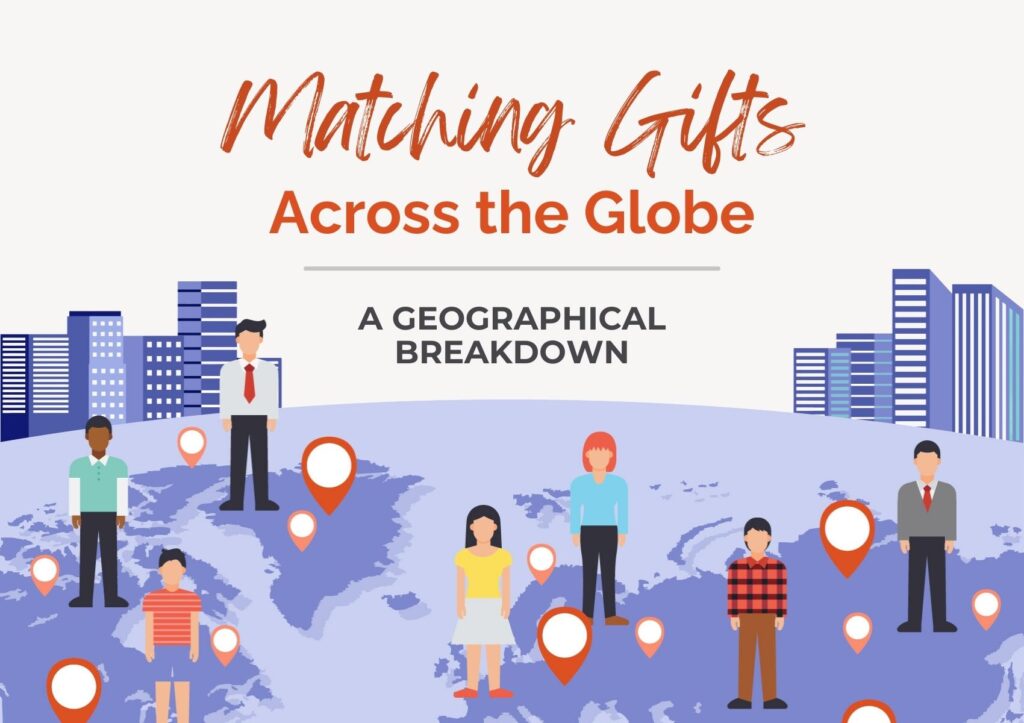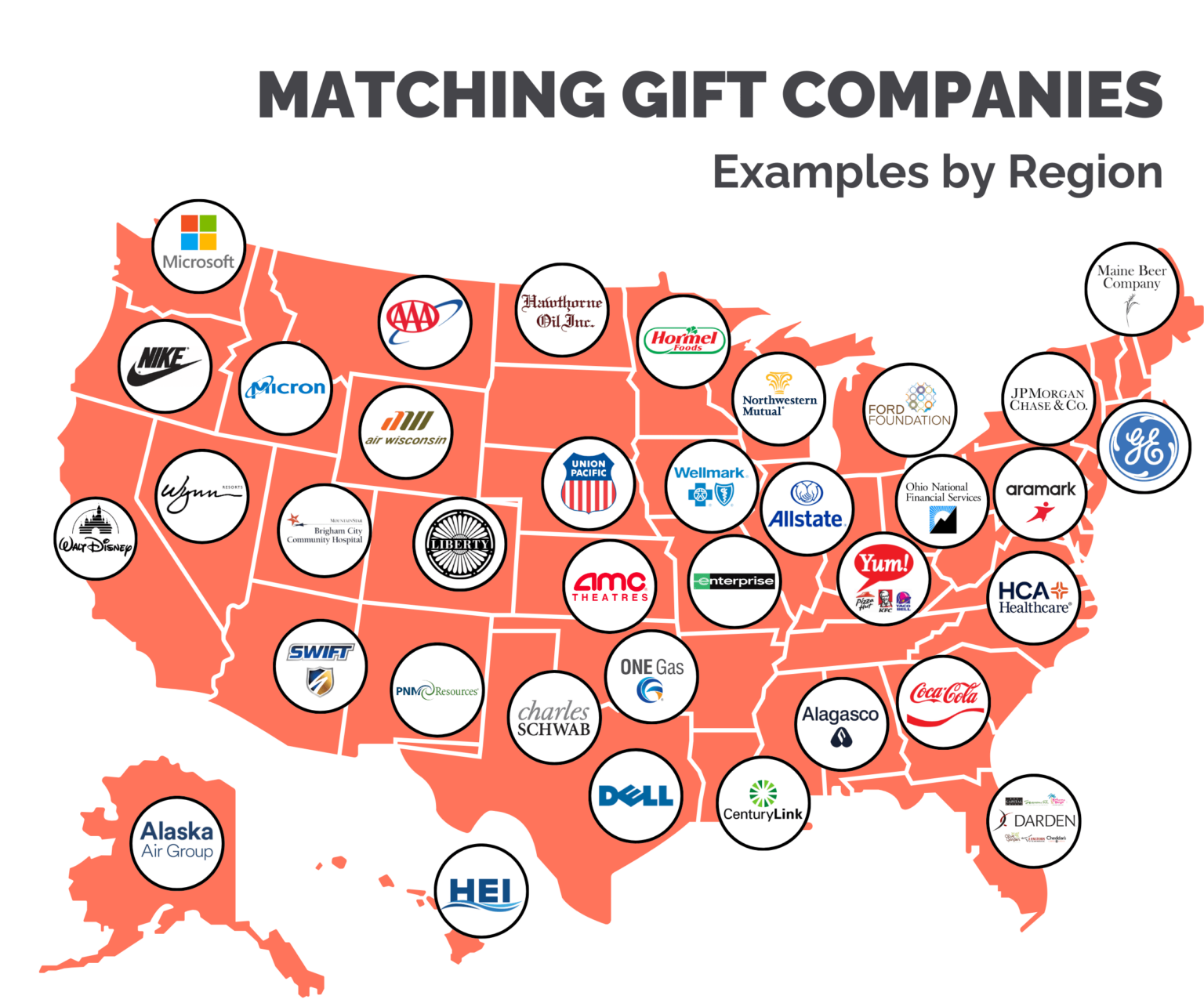Matching Gifts Across the Globe | A Geographical Breakdown


Matching gifts are invaluable assets in nonprofit fundraising. They double the impact of donors’ personal contributions and supply an additional, much-needed source of revenue for the organization.
However, while the concept of matching gifts is universal, the companies that offer such programs can vary significantly by location. So, how do you know if your organization is situated in a matching gift hub? And how can you position your team for ultimate success even if it’s not?
In this guide, we’ll delve into the widespread landscape of matching gifts as we answer these questions and more:
- Which companies match employees’ charitable gifts?
- Which nonprofits qualify for funding from matching gifts?
- Does matching gift eligibility vary by location?
- How does the digital revolution impact match eligibility by region?
- How does the shifting philanthropy landscape impact match eligibility?
Let’s begin!
1. Which companies match employees’ charitable gifts?
Tens of thousands of companies currently offer generous matching gift programs to support their employees’ charitable giving. Though we can’t list them all here, some of the largest and most well-known suppliers of matching gifts include:
- Google → See program guidelines.
- Microsoft → See program guidelines.
- Apple → See program guidelines.
- IBM → See program guidelines.
- Johnson & Johnson → See program guidelines.
- Bank of America → See program guidelines.
- JPMorgan Chase & Co. → See program guidelines.
- Wells Fargo → See program guidelines.
- Coca-Cola Company → See program guidelines.
- Boeing → See program guidelines.
- And more → See more companies!
Matching gift programs are increasingly spanning companies of all shapes, sizes, sectors, and regions. However, these initiatives have historically been led by the largest enterprise-level businesses—including over 65% of the Fortune 500. High rates of participation are often seen among employers in the technology, financial services, and healthcare industries.
Today, smaller and mid-sized corporations are joining the ranks to launch generous matching gift programs for their employees, too. That means program availability now spans more regions and has wider coverage than traditionally thought!
2. Which nonprofits qualify for funding from matching gifts?
Each company that matches gifts first defines the donation types it will match. Though it can vary, this generally includes the kinds of organizations to which it will contribute funds.
Still, most employers agree to match donations to nearly any organization registered as a tax-exempt nonprofit under section 501(c)(3) of the Internal Revenue Code. These tend to encompass a wide range of charitable organizations, such as:
- Higher educational institutions (e.g., colleges and universities)
- K-12 schools (e.g., elementary, middle, and high schools)
- Health and human services (e.g., research institutes, hospital facilities, etc.)
- Arts and cultural groups (e.g., museums, theaters, performing arts centers)
- Civic and community organizations (e.g., youth programs, advocacy groups)
- Environmental causes (e.g., nature preservations, ocean conservancy efforts)
- And many other 501(c)(3) nonprofits (or the international equivalent for global organizations)
Although the guidelines themselves vary by employer, the most commonly noted exceptions to companies’ matching gift programs are organizations that are strictly religious or political in nature. Nonetheless, religiously affiliated groups that operate programs or services for the public benefit (such as a soup kitchen or homeless shelter) do tend to qualify.
Meanwhile, some companies offer what are known as “Restricted” programs, where employees can only request matches for gifts made to a specific subset of organizations. For example, a company focused on sustainability practices may center its matching initiatives on organizations operating strictly within the environmental sector.
Recent research indicates that most companies are moving away from restricted programs (a decrease of 33%) and opting for unrestricted ones (an increase of 48%) instead.
It’s also worth noting that most companies’ program guidelines do not require their employees to support organizations within a defined geographic area but rather encourage generous giving to causes near and far. And that means a larger number of nonprofits ultimately benefiting from matching gifts!
3. Does matching gift eligibility vary by location?
Employee matching gifts are one of the most widely available forms of corporate philanthropy, with companies offering programs worldwide. However, the majority of known matching gift programs seem to be centered in North America (i.e., the United States and Canada), with additional offerings in Western Europe and Australia.
So, what does that mean for your organization and its qualification for the programs? Does a nonprofit’s eligibility vary by location?
There are a few key factors that play a role in determining the answer. These generally include:
- Companies’ program guidelines — While most matching gift programs are open to verified nonprofits regardless of their geographic location, certain employers may implement specific location-based restrictions for the organizations they support. For example, a business headquartered in New York City might require matching gifts to support New York-based nonprofits as a way to enhance its impact on its local communities.
- The presence of large businesses in your community — Enterprise-level corporations remain the most likely to offer generous matching gift programs for their employees. As these types of businesses tend to congregate in significant corporate hubs (think: Silicon Valley) and employ large numbers of individuals, organizations operating nearby can expect to see heightened levels of matching gift eligibility.

All in all, the average matching gift eligibility rate tends to remain fairly steady at ~10%.
Regardless of location, the bottom line is that your organization should review each company’s matching gift guidelines and eligibility criteria to determine your best course of action. Fortunately, donors can often find this information—and initiate the matching gift request process—with a quick search of a matching gift database like Double the Donation.
4. How does the digital revolution impact match eligibility by region?
In recent years, there’s been a notable shift in the nonprofit and corporate landscapes alike—the continuous move toward the digital age. Fortunately for your organization, that means more matching gift opportunities regardless of where your team is situated.
This occurrence is due to a few leading considerations:
The rise of virtual giving
The movement toward virtual giving, accelerated by the digital revolution and made possible by innovative online giving tools, has made it easier for organizations to engage supporters regardless of their geography. As a result, individuals can give (and get their gifts matched) to their favorite organizations regardless of physical location, allowing for greater flexibility and more inclusive programming.
- Example: A Boston-based employee from a New England company giving to your international relief organization online despite living hundreds of miles from the center of your operations
Increased adoption of remote work
Since the onset of COVID-19, more employees have adopted a work-from-home model (~13%) than ever before. As this trend continues, again powered by smart technology, it means workforces are less geographically focused—and matching gifts are more widely available.
- Example: An employee from a California-centered company that lives in the rural Midwest and supports your local-to-them Kansas-based nonprofit
Expansion of corporate chains
While many enterprise-level employers are focused in a few concentrated regions, these companies’ impact extends far beyond their headquarters alone. In fact, nearly all of the largest corporations employ staff at tons of different branches across the U.S. and beyond. Most often, team members at all corporate locations qualify for matching gifts, which means more accessible opportunities for nonprofits.
- Example: An employee from a company headquartered in Texas who works for a Florida branch and gives to your Florida-based nonprofit
Introduction of new matching gift programs
In addition to questions of eligibility according to physical location, matching gifts are also becoming a more prominent corporate philanthropy offering overall. In the last three years, Double the Donation research reports that the percentage of companies that match gifts grew by an estimated 12%. At the same time, the portion of employers offering “Unrestricted Matching Gift Programs” (meaning they’ll match donations to any nonprofit) nearly doubled.
When more companies participate in corporate giving by offering accessible giving programs, nonprofits have greater access to matching gift opportunities overall.
- Example: An employee from a company offering a brand new matching gift program gives and gets their gift matched to your organization
Thanks to burgeoning trends like these, matching gifts are becoming increasingly decentralized and accessible to all types of organizations. As a result, donors can better leverage corporate philanthropy to maximize the impact of their charitable giving, regardless of geographic bounds.
Wrapping Up
So, all in all, how much does a nonprofit’s physical location—and its donors’ geographic makeup—impact the organization’s matching gift eligibility? Perhaps a bit. However, the rise of online giving and globally inclusive philanthropy have led to significant growth in program accessibility worldwide.
While certain regions may boast increasingly concentrated levels of matching gifts, the landscape is rapidly evolving to remove physical barriers more and more. That means investing in matching gifts can yield significant returns in terms of funding and engagement regardless of where your organization is located.
The bottom line? Whether your organization is situated in a bustling urban center or a remote rural community, the potential to leverage matching gifts has never been greater.
Interested in learning more about matching gifts and how to maximize your return from the programs? Check out these additional resources:
- Double the Donation’s Ultimate Guide to Marketing Matching Gifts. Explore more top companies matching gifts and how your organization can make the most of them. Hint: It starts with marketing the opportunity to your donors.
- What 11 Nonprofits Have to Say About Matching Gift Automation. Automation can scale up any fundraising strategy. See what other organizations have had to say about streamlining their efforts with leading matching gift solutions!
- Matching Gift Resources by Provider | A Competitive Review. Looking for even more educational materials to inform your team on matching gifts and beyond? This resource compares available resources and where you can access them!



